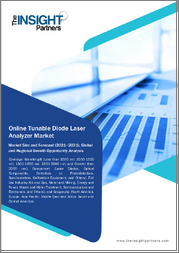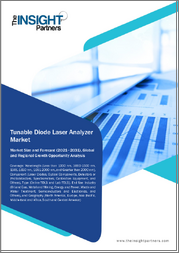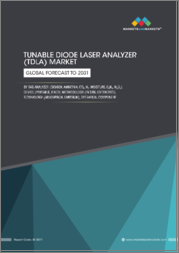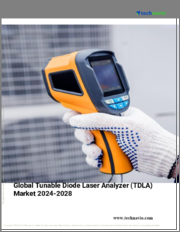
|
시장보고서
상품코드
1551244
파장 가변 다이오드 레이저 분석기 시장 예측(-2030년) : 유형별, 구성요소별, 작동 모드별, 기술별, 용도별, 최종사용자, 지역별 세계 분석Tunable Diode Laser Analyzer Market Forecasts to 2030 - Global Analysis By Type (Single-Wavelength and Multi-Wavelength), Component, Mode of Operation, Technology, Application, End User and By Geography |
||||||
Stratistics MRC에 따르면, 파장 가변 다이오드 레이저 분석기(TDLA) 세계 시장은 2024년 5억 2만 달러로 예측 기간 동안 CAGR 9.2%로 성장하여 2030년에는 8억 1,024만 달러에 달할 것으로 예상됩니다.
파장 가변 다이오드 레이저 분석기(TDLA)는 파장 가변 다이오드 레이저를 사용하여 시료 내 특정 가스의 농도를 측정하는 첨단 분석기입니다. 레이저를 다른 파장으로 조정함으로써 TDLA는 고유한 흡수 특성에 따라 다양한 가스를 감지하고 정량화할 수 있습니다. 이 기술은 고감도, 고선택성으로 인해 환경 모니터링, 산업 공정 제어, 배출가스 분석 등의 용도에 적합합니다.
실시간 모니터링에 대한 수요 증가
산업계와 규제 기관이 공정 제어 및 환경 규정 준수를 위해 지속적이고 정확한 데이터를 필요로 하는 상황에서 TDLA 기술은 CO, NOx, VOC와 같은 가스를 실시간으로 정확하게 측정할 수 있는 TDLA의 능력은 적시에 의사결정을 내리고 상황 변화에 빠르게 대응할 수 있도록 지원합니다. 의사결정과 상황 변화에 대한 신속한 대응을 지원합니다. 이 기능은 운영 효율성, 안전 및 규정 준수를 향상시켜 발전, 제조, 환경 모니터링 등의 분야에서 채택이 증가하고 있습니다.
복잡한 운영
TDLA 운영의 복잡성은 설정, 교정 및 유지보수에 전문 지식이 필요한 첨단 기술에서 기인합니다. 이러한 복잡성은 적절한 작동을 위한 기술적 전문 지식이나 리소스가 없는 사용자에 대한 채택을 제한하고 시장 성장을 저해할 수 있습니다. 높은 교육 요구 사항과 잠재적인 운영상의 어려움으로 인해 비용이 증가하고 도입 기간이 길어질 수 있습니다. 그 결과, 업계는 더 간단하고 사용자 친화적인 옵션을 선택하게 되어 TDLA 시장의 보급과 성장이 둔화될 수 있습니다.
산업용 애플리케이션의 성장
석유 및 가스, 화학 제조, 발전, 제약 등의 산업에서는 공정 최적화, 안전 보장, 환경 규제 준수를 위해 가스 농도의 정확한 측정이 필요합니다. 산업 활동이 확대되고 진화함에 따라 TDLA와 같은 고급 분석 도구의 필요성이 증가하고 있습니다. 다양하고 가혹한 환경에서 고감도, 고선택성, 고신뢰성을 제공하는 TDLA의 능력은 다양한 산업 응용 분야를 지원하여 시장 확대와 기술 채택을 촉진하고 있습니다.
정기적인 유지보수 및 교정
정기적인 유지보수 및 교정은 TDLA의 정확하고 신뢰할 수 있는 성능을 장기간 유지하기 위해 필수적입니다. 이러한 프로세스에는 분석기 구성요소 점검 및 조정, 센서 재교정, 마모된 부품 교체 등이 포함됩니다. 잦은 유지보수 및 교정의 필요성은 운영 비용을 증가시키고 전문 인력이 필요합니다. 이러한 추가 비용과 복잡성은 일부 잠재적 사용자의 TDLA에 대한 접근성과 비용 효율성을 떨어뜨리고 보급을 제한하여 시장 성장을 저해할 수 있습니다.
COVID-19의 영향
COVID-19 팬데믹으로 인해 TDLA 시장은 초기에는 공급망 중단, 산업 활동 감소, 프로젝트 실행 지연 등의 혼란을 겪었습니다. 그러나 팬데믹은 보건 및 안전 애플리케이션에서 실시간 정확한 모니터링의 중요성을 부각시키며 TDLA 기술에 대한 관심을 높이는 원동력이 되었습니다. 팬데믹 이후 산업계가 재가동되면서 시장은 회복과 성장을 거듭하고 있으며, 환경 규제에 대한 관심이 높아지면서 산업 및 환경 분야 모두에서 첨단 모니터링 솔루션에 대한 수요가 증가하고 있습니다.
예측 기간 동안 산업 배출가스 모니터링 분야가 가장 큰 비중을 차지할 것으로 예상됩니다.
산업용 배출가스 모니터링 분야는 가스 농도를 실시간으로 정확하게 감지할 수 있기 때문에 성장 가능성이 높으며, TDLA는 높은 감도와 선택성을 제공하여 CO, NOx, VOC와 같은 오염 물질을 정확하게 측정할 수 있습니다. 열악한 산업 환경에서 작동하고 지속적으로 신뢰할 수 있는 데이터를 제공하는 능력은 효과적인 배출 제어 및 관리를 지원합니다. 이 기술은 산업계가 환경에 미치는 영향을 줄이고, 벌금을 피하고, 배출가스가 규제치 이내로 유지되도록함으로써 공정 효율을 높이는 데 도움이 됩니다.
예측 기간 동안 가장 높은 CAGR을 보일 것으로 예상되는 분야는 발전 분야입니다.
예측 기간 동안 가장 높은 CAGR을 보일 것으로 예상되는 분야는 발전 분야로, TDLA는 연소 공정 모니터링 및 최적화에 중요한 역할을 하며, 최적의 연소 상태를 유지하고, 배출 가스를 줄이며, 전반적인 효율성을 향상시키는 데 도움이 됩니다. TDLA는 미량 가스를 민감하게 감지하고 분석하여 운전 파라미터를 적시에 조정하여 연료 사용 및 환경 규제 준수를 향상시키는 동시에 운전 비용과 환경 영향을 최소화할 수 있습니다.
가장 높은 점유율을 보이는 지역
아시아태평양은 산업화, 엄격한 환경 규제, 인프라 및 환경 모니터링에 대한 투자 증가로 인해 TDLA 시장이 빠르게 성장하고 있습니다. 주요 촉진요인으로는 석유 및 가스, 제조업, 발전 등의 부문에서 수요 증가와 대기질 및 안전 개선을 위한 정부의 노력 등이 있습니다. 이 지역의 급속한 산업 성장과 기술 발전에 대한 집중은 시장 성장을 더욱 촉진하고 있습니다.
CAGR이 가장 높은 지역:
북미에서는 엄격한 환경 규제, 기술 발전, 산업 안전 및 공정 최적화에 대한 강한 집중으로 인해 TDLA 시장이 견조한 성장세를 보이고 있습니다. 석유 및 가스, 화학 제조, 발전 등 정확한 가스 모니터링이 중요한 산업이 수요를 주도하고 있습니다. 청정 기술 및 실시간 배출가스 모니터링을 촉진하는 정부 정책은 시장 성장을 더욱 촉진하고 있습니다. 또한, 주요 기업의 존재와 TDLA 기술의 지속적인 혁신은 이 지역 세계 시장에서의 선도적 지위에 기여하고 있습니다.
무료 커스터마이징 서비스
이 보고서를 구독하는 고객은 다음과 같은 무료 맞춤화 옵션 중 하나를 사용할 수 있습니다.
- 기업 개요
- 추가 시장 기업 종합 프로파일링(최대 3개사까지)
- 주요 기업 SWOT 분석(최대 3개사)
- 지역 세분화
- 고객의 관심에 따른 주요 국가별 시장 추정치, 예측, CAGR(주: 타당성 검토에 따른)
- 경쟁사 벤치마킹
- 제품 포트폴리오, 지리적 입지, 전략적 제휴를 기반으로 한 주요 기업 벤치마킹
목차
제1장 주요 요약
제2장 서문
- 개요
- 이해관계자
- 조사 범위
- 조사 방법
- 데이터 마이닝
- 데이터 분석
- 데이터 검증
- 조사 접근법
- 조사 정보 출처
- 1차 조사 정보 출처
- 2차 조사 정보 출처
- 가정
제3장 시장 동향 분석
- 성장 촉진요인
- 성장 억제요인
- 기회
- 위협
- 기술 분석
- 용도 분석
- 최종사용자 분석
- 신흥 시장
- COVID-19의 영향
제4장 Porter's Five Forces 분석
- 공급 기업의 교섭력
- 구매자의 교섭력
- 대체품의 위협
- 신규 참여업체의 위협
- 경쟁 기업 간의 경쟁 관계
제5장 세계의 파장 가변 다이오드 레이저 분석기 시장 : 유형별
- 단일 파장
- 멀티 파장
제6장 세계의 파장 가변 다이오드 레이저 분석기 시장 : 구성요소별
- 레이저 다이오드
- 광학 부품
- 검출기/광검출기
- 분광계
- 샘플 셀
- 데이터 수집 시스템
- 교정 기기
- 기타
제7장 세계의 파장 가변 다이오드 레이저 분석기 시장 : 동작 모드별
- 연속파(CW)
- 펄스파
- 처프파
- 변조파
- 기타
제8장 세계의 파장 가변 다이오드 레이저 분석기 시장 : 기술별
- 흡수 분광법
- 발광 분광법
- 광음향 분광법
- 주파수변조 분광법(FMS)
- 기타
제9장 세계의 파장 가변 다이오드 레이저 분석기 시장 : 용도별
- 환경 모니터링
- 프로세스 모니터링
- 산업 배출 모니터링
- 가스 분석
- 기타
제10장 세계의 파장 가변 다이오드 레이저 분석기 시장 : 최종사용자별
- 화학·석유화학
- 발전
- 헬스케어
- 자동차
- 식품·음료
- 기타
제11장 세계의 파장 가변 다이오드 레이저 분석기 시장 : 지역별
- 북미
- 미국
- 캐나다
- 멕시코
- 유럽
- 독일
- 영국
- 이탈리아
- 프랑스
- 스페인
- 기타 유럽
- 아시아태평양
- 일본
- 중국
- 인도
- 호주
- 뉴질랜드
- 한국
- 기타 아시아태평양
- 남미
- 아르헨티나
- 브라질
- 칠레
- 기타 남미
- 중동 및 아프리카
- 사우디아라비아
- 아랍에미리트
- 카타르
- 남아프리카공화국
- 기타 중동 및 아프리카
제12장 주요 발전
- 계약, 파트너십, 협업, 합작투자
- 인수와 합병
- 신제품 발매
- 사업 확대
- 기타 주요 전략
제13장 기업 개요
- Emerson Electric Corporation
- Honeywell International Inc.
- ABB Limited
- Siemens AG
- Thermo Fisher Scientific Inc.
- Horiba Limited
- Yokogawa Electric Corporation
- Andover Corporation
- LumaSense Technologies Inc.
- Servomex Group
- KROHNE Group
- Process Analytics
- MKS Instruments Inc.
- Sierra Instruments Inc.
- SPECTRO Analytical Instruments GmbH
- Envea Global
According to Stratistics MRC, the Global Tunable Diode Laser Analyzer Market is accounted for $500.02 million in 2024 and is expected to reach $810.24 million by 2030 growing at a CAGR of 9.2% during the forecast period. A tunable diode laser analyzer is an advanced analytical instrument that uses a tunable diode laser to measure concentrations of specific gases in a sample. By tuning the laser to different wavelengths, the TDLA can detect and quantify various gases based on their unique absorption characteristics. This technology is highly sensitive and selective, making it suitable for applications in environmental monitoring, industrial process control, and emissions analysis. T
Market Dynamics:
Driver:
Rising demand for real-time monitoring
As industries and regulatory bodies increasingly require continuous, accurate data for process control and environmental compliance, TDLA technology becomes essential. Its ability to provide real-time, precise measurements of gases such as CO, NOx, and VOCs supports timely decision-making and rapid response to changing conditions. This capability enhances operational efficiency, safety, and regulatory compliance, driving adoption across sectors like power generation, manufacturing, and environmental monitoring.
Restraint:
Complexity of operation
The complexity of operation in TDLAs arises from their sophisticated technology, which requires specialized knowledge for setup, calibration, and maintenance. This complexity can hinder market growth by limiting adoption among users who lack the technical expertise or resources for proper operation. High training requirements and potential operational difficulties can lead to increased costs and longer implementation times. As a result, industries may opt for simpler, more user-friendly alternatives, potentially slowing the broader adoption and growth of TDLAs in the market.
Opportunity:
Growing industrial applications
Industries such as oil and gas, chemical manufacturing, power generation, and pharmaceuticals require accurate measurement of gas concentrations to optimize processes, ensure safety, and comply with environmental regulations. As industrial activities expand and evolve, the need for advanced analytical tools like TDLAs grows. Their ability to deliver high sensitivity, selectivity, and reliability in diverse and harsh environments supports various industrial applications, thereby propelling market expansion and technological adoption.
Threat:
Regular maintenance and calibration
Regular maintenance and calibration are essential for TDLAs to ensure accurate and reliable performance over time. These processes involve checking and adjusting the analyzer's components, recalibrating the sensors, and replacing worn parts. The need for frequent maintenance and calibration can increase operational costs and require specialized personnel. This additional expense and complexity can hamper market growth by making TDLAs less accessible and cost-effective for some potential users, limiting their widespread adoption.
Covid-19 Impact
The covid-19 pandemic initially disrupted the TDLA market due to supply chain interruptions, reduced industrial activity, and delays in project implementations. However, the pandemic also highlighted the importance of real-time, accurate monitoring in health and safety applications, driving increased interest in TDLA technology. Post-pandemic, the market has seen recovery and growth as industries resume operations, with heightened focus on environmental regulations and advanced monitoring solutions for both industrial and environmental applications, boosting demand for TDLA systems.
The industrial emission monitoring segment is expected to be the largest during the forecast period
The industrial emission monitoring segment is estimated to have a lucrative growth, due to their precise and real-time detection of gas concentrations. TDLAs provide high sensitivity and selectivity, enabling accurate measurement of pollutants such as CO, NOx, and VOCs. Their ability to operate in harsh industrial environments and deliver continuous, reliable data supports effective emission control and management. This technology helps industries reduce environmental impact, avoid fines, and enhance process efficiency by ensuring emissions stay within regulatory limits.
The power generation segment is expected to have the highest CAGR during the forecast period
The power generation segment is anticipated to witness the highest CAGR growth during the forecast period. TDLAs play a crucial role in monitoring and optimizing combustion processes. TDLAs help in maintaining optimal combustion conditions, reducing emissions, and improving overall efficiency. By detecting and analyzing trace gases with high sensitivity, TDLAs enable timely adjustments to operational parameters, enhancing fuel utilization and compliance with environmental regulations, while minimizing operational costs and environmental impact.
Region with largest share:
In the Asia-Pacific region, the TDLA market is expanding rapidly due to growing industrialization, stringent environmental regulations, and increasing investments in infrastructure and environmental monitoring. Key drivers include rising demand from sectors like oil and gas, manufacturing, and power generation, coupled with government initiatives to improve air quality and safety. The region's rapid industrial growth and focus on technology advancement are further fueling market growth.
Region with highest CAGR:
In North America, the TDLA market is robust due to stringent environmental regulations, technological advancements, and a strong focus on industrial safety and process optimization. The demand is driven by industries such as oil and gas, chemical manufacturing, and power generation, where precise gas monitoring is crucial. Government policies promoting cleaner technologies and real-time emissions monitoring further support market growth. Additionally, the presence of key players and continuous innovation in TDLA technology contribute to the region's leading position in the global market.
Key players in the market
Some of the key players profiled in the Tunable Diode Laser Analyzer Market include Emerson Electric Corporation, Honeywell International Inc., ABB Limited, Siemens AG, Thermo Fisher Scientific Inc., Horiba Limited, Yokogawa Electric Corporation, Andover Corporation, LumaSense Technologies Inc., Servomex Group, KROHNE Group, Process Analytics, MKS Instruments Inc., Sierra Instruments Inc., SPECTRO Analytical Instruments GmbH and Envea Global.
Key Developments:
In February 2024, Yokogawa Corporation of America released the Extractive Tunable Diode Laser Spectrometer TDLS8220, a new generation OpreX(TM) Analyzer product. This product joins Yokogawa's existing lineup that includes the in-situ TDLS8000 and probe type TDLS8100/TDLS8200. The TDLS8220 plays a key role in ensuring accurate and reliable oxygen measurements for safe continuous operation.
In November 2022, ENVEA presented LAS-5000XD, an advanced in-situ laser tunable diode laser spectroscopy (TDLS) gas analyzer. It measures gas concentrations directly in the process stream, without needing sample conditioning or extraction. The LAS-5000XD is positioned as a state-of-the-art solution for industries needing precise, real-time gas analysis, contributing to improved operational efficiency and regulatory compliance.
Types Covered:
- Single-Wavelength
- Multi-Wavelength
Components Covered:
- Laser Diodes
- Optical Components
- Detector/Photodetectors
- Spectrometers
- Sample Cells
- Data Acquisition Systems
- Calibration Equipment
- Other Components
Mode of Operations Covered:
- Continuous Wave (CW)
- Pulsed Wave
- Chirped Wave
- Modulated Wave
- Other Mode of Operations
Technologies Covered:
- Absorption Spectroscopy
- Emission Spectroscopy
- Photoacoustic Spectroscopy
- Frequency Modulation Spectroscopy (FMS)
- Other Technologies
Applications Covered:
- Environmental Monitoring
- Process Monitoring
- Industrial Emission Monitoring
- Gas Analysis
- Other Applications
End Users Covered:
- Chemical & Petrochemical
- Power Generation
- Healthcare
- Automotive
- Food & Beverages
- Other End Users
Regions Covered:
- North America
- US
- Canada
- Mexico
- Europe
- Germany
- UK
- Italy
- France
- Spain
- Rest of Europe
- Asia Pacific
- Japan
- China
- India
- Australia
- New Zealand
- South Korea
- Rest of Asia Pacific
- South America
- Argentina
- Brazil
- Chile
- Rest of South America
- Middle East & Africa
- Saudi Arabia
- UAE
- Qatar
- South Africa
- Rest of Middle East & Africa
What our report offers:
- Market share assessments for the regional and country-level segments
- Strategic recommendations for the new entrants
- Covers Market data for the years 2022, 2023, 2024, 2026, and 2030
- Market Trends (Drivers, Constraints, Opportunities, Threats, Challenges, Investment Opportunities, and recommendations)
- Strategic recommendations in key business segments based on the market estimations
- Competitive landscaping mapping the key common trends
- Company profiling with detailed strategies, financials, and recent developments
- Supply chain trends mapping the latest technological advancements
Free Customization Offerings:
All the customers of this report will be entitled to receive one of the following free customization options:
- Company Profiling
- Comprehensive profiling of additional market players (up to 3)
- SWOT Analysis of key players (up to 3)
- Regional Segmentation
- Market estimations, Forecasts and CAGR of any prominent country as per the client's interest (Note: Depends on feasibility check)
- Competitive Benchmarking
- Benchmarking of key players based on product portfolio, geographical presence, and strategic alliances
Table of Contents
1 Executive Summary
2 Preface
- 2.1 Abstract
- 2.2 Stake Holders
- 2.3 Research Scope
- 2.4 Research Methodology
- 2.4.1 Data Mining
- 2.4.2 Data Analysis
- 2.4.3 Data Validation
- 2.4.4 Research Approach
- 2.5 Research Sources
- 2.5.1 Primary Research Sources
- 2.5.2 Secondary Research Sources
- 2.5.3 Assumptions
3 Market Trend Analysis
- 3.1 Introduction
- 3.2 Drivers
- 3.3 Restraints
- 3.4 Opportunities
- 3.5 Threats
- 3.6 Technology Analysis
- 3.7 Application Analysis
- 3.8 End User Analysis
- 3.9 Emerging Markets
- 3.10 Impact of Covid-19
4 Porters Five Force Analysis
- 4.1 Bargaining power of suppliers
- 4.2 Bargaining power of buyers
- 4.3 Threat of substitutes
- 4.4 Threat of new entrants
- 4.5 Competitive rivalry
5 Global Tunable Diode Laser Analyzer Market, By Type
- 5.1 Introduction
- 5.2 Single-Wavelength
- 5.3 Multi-Wavelength
6 Global Tunable Diode Laser Analyzer Market, By Component
- 6.1 Introduction
- 6.2 Laser Diodes
- 6.3 Optical Components
- 6.4 Detector/Photodetectors
- 6.5 Spectrometers
- 6.6 Sample Cells
- 6.7 Data Acquisition Systems
- 6.8 Calibration Equipment
- 6.9 Other Components
7 Global Tunable Diode Laser Analyzer Market, By Mode of Operation
- 7.1 Introduction
- 7.2 Continuous Wave (CW)
- 7.3 Pulsed Wave
- 7.4 Chirped Wave
- 7.5 Modulated Wave
- 7.6 Other Mode of Operations
8 Global Tunable Diode Laser Analyzer Market, By Technology
- 8.1 Introduction
- 8.2 Absorption Spectroscopy
- 8.3 Emission Spectroscopy
- 8.4 Photoacoustic Spectroscopy
- 8.5 Frequency Modulation Spectroscopy (FMS)
- 8.6 Other Technologies
9 Global Tunable Diode Laser Analyzer Market, By Application
- 9.1 Introduction
- 9.2 Environmental Monitoring
- 9.3 Process Monitoring
- 9.4 Industrial Emission Monitoring
- 9.5 Gas Analysis
- 9.6 Other Applications
10 Global Tunable Diode Laser Analyzer Market, By End User
- 10.1 Introduction
- 10.2 Chemical & Petrochemical
- 10.3 Power Generation
- 10.4 Healthcare
- 10.5 Automotive
- 10.6 Food & Beverages
- 10.7 Other End Users
11 Global Tunable Diode Laser Analyzer Market, By Geography
- 11.1 Introduction
- 11.2 North America
- 11.2.1 US
- 11.2.2 Canada
- 11.2.3 Mexico
- 11.3 Europe
- 11.3.1 Germany
- 11.3.2 UK
- 11.3.3 Italy
- 11.3.4 France
- 11.3.5 Spain
- 11.3.6 Rest of Europe
- 11.4 Asia Pacific
- 11.4.1 Japan
- 11.4.2 China
- 11.4.3 India
- 11.4.4 Australia
- 11.4.5 New Zealand
- 11.4.6 South Korea
- 11.4.7 Rest of Asia Pacific
- 11.5 South America
- 11.5.1 Argentina
- 11.5.2 Brazil
- 11.5.3 Chile
- 11.5.4 Rest of South America
- 11.6 Middle East & Africa
- 11.6.1 Saudi Arabia
- 11.6.2 UAE
- 11.6.3 Qatar
- 11.6.4 South Africa
- 11.6.5 Rest of Middle East & Africa
12 Key Developments
- 12.1 Agreements, Partnerships, Collaborations and Joint Ventures
- 12.2 Acquisitions & Mergers
- 12.3 New Product Launch
- 12.4 Expansions
- 12.5 Other Key Strategies
13 Company Profiling
- 13.1 Emerson Electric Corporation
- 13.2 Honeywell International Inc.
- 13.3 ABB Limited
- 13.4 Siemens AG
- 13.5 Thermo Fisher Scientific Inc.
- 13.6 Horiba Limited
- 13.7 Yokogawa Electric Corporation
- 13.8 Andover Corporation
- 13.9 LumaSense Technologies Inc.
- 13.10 Servomex Group
- 13.11 KROHNE Group
- 13.12 Process Analytics
- 13.13 MKS Instruments Inc.
- 13.14 Sierra Instruments Inc.
- 13.15 SPECTRO Analytical Instruments GmbH
- 13.16 Envea Global



















